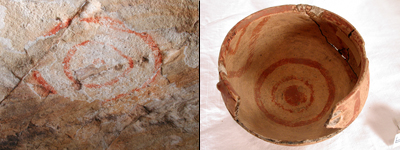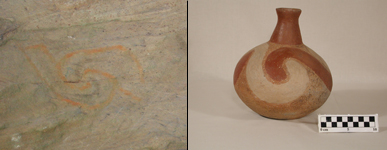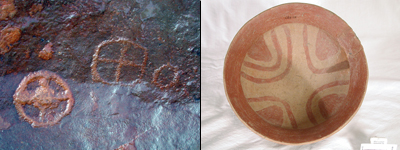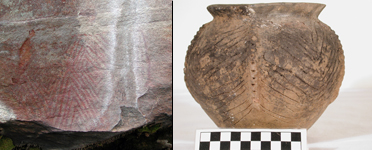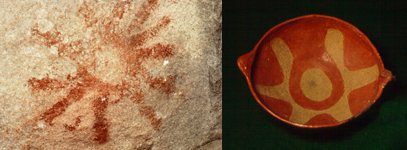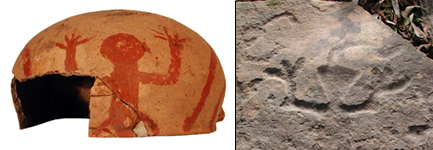|
Rock Art in Context:
Mississippian Art in the Central Arkansas River Valley By Leslie Walker Arkansas Indians decorated a variety of objects with art: pottery vessels, basketry, and woven textiles are three kinds of artifact media used for artistic expression. Many of these portable artifacts carry motifs also found in rock art. Decorated pottery vessels and basketry from archeological sites in the central Arkansas River Valley share a particularly large series of corresponding motifs with local rock art. Geometric Motifs Concentric Circle: One of the most commonly shared motifs is the concentric circle, shown here on rock art from Carrion Crow Mountain and on a ceramic vessel from Carden Bottom. Woven textile fragments preserved at the Spiro site also exhibit this motif.
Spiral: The spiral motif is a less common variant of the concentric circle motif. Here it is shown as a pictograph and as a ceramic vessel decoration.
Interlocking Scrolls: Yet another variant of the circle motif, even less common in rock art but often found as a ceramic vessel design.
Cross-in-Circle: The cross-in-circle is found on a variety of artifact media. Here it is shown in rock art and on pottery. Notice that the non-painted interior surface of the pottery bowl forms a cross, while the painted rim forms an enclosing circle.
Nested (or filled) Triangles and Diamonds: Nested (or filled) triangle and diamond motifs are also common. Here are rock art and pottery examples.
Naturalistic Motifs Sunburst: The sunburst is a common rock art motif that we also find as a decoration on ceramics and basketry.
Human figures: The human figure is a frequent subject of rock art that is sometimes also observed on ceramics. Note the similar arm postures on these two examples.
Animal figures: These, too, are frequent subjects of rock art that sometimes find expression on ceramic vessels. Here we compare rabbit motifs.
Spirit figures: Southeastern Indians often represented spirit beings as figures that embody a mix of elements from separate species, particularly those associated with Above (sky) and Below (water) realms. The winged serpent is an archetypal figure, representing a spirit being associated with the Below World. Historic Cherokee Indians called this creature an Uktena. Here we can see examples of its imagery in rock art and pottery forms.
Summary These examples illustrate how ancient Arkansas Indians repeated artistic motifs on a variety of media, including fixed-in-place rock art and portable artifacts. These motifs must have conveyed important concepts or meanings associated with different activities. Additional research may help decipher these meanings and explore the contexts of their use. |
